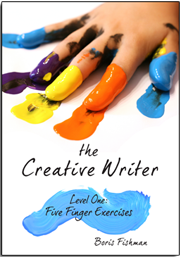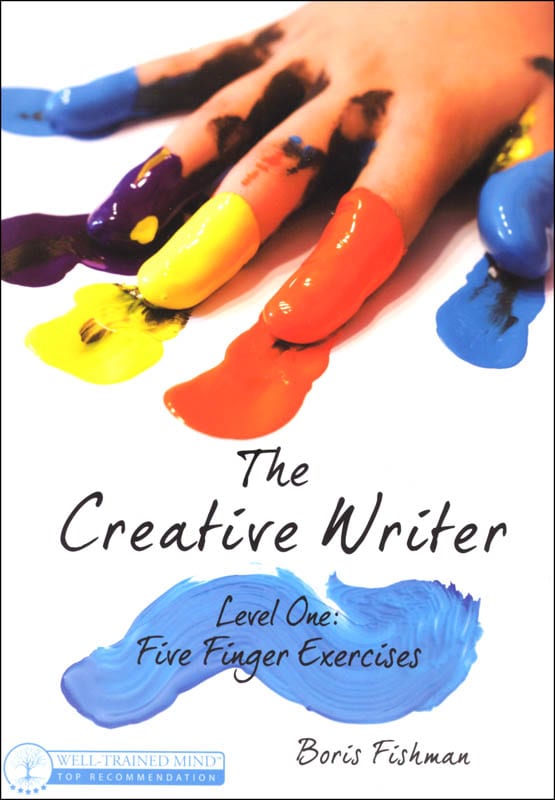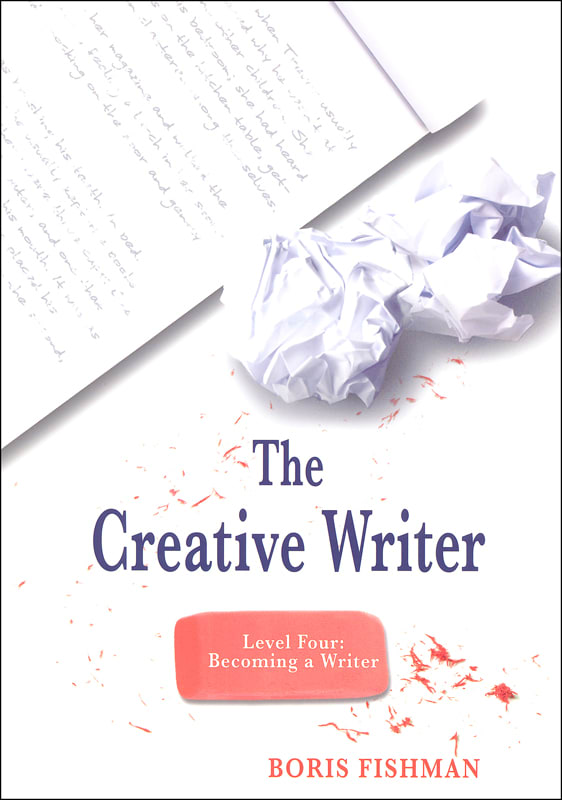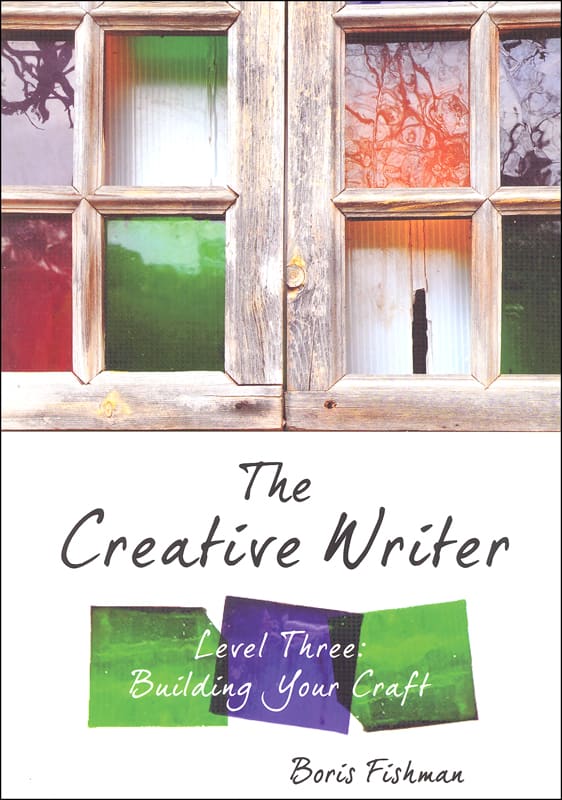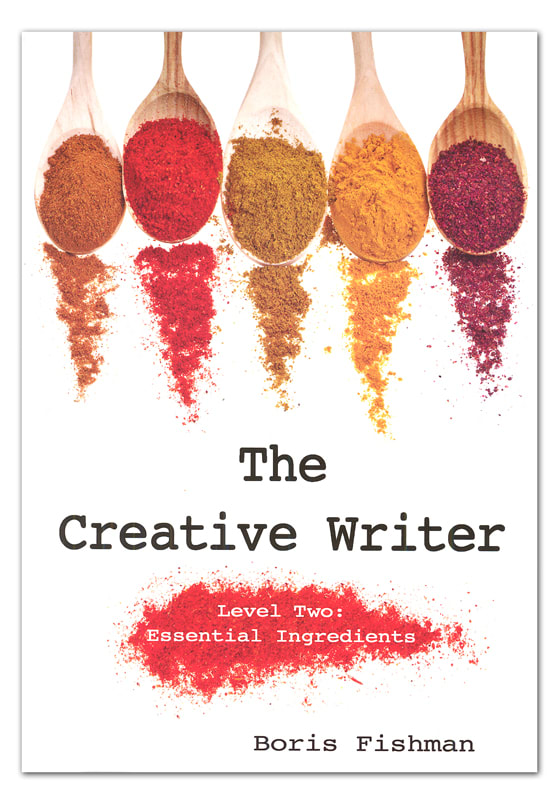The Creative Writer is a series of four courses, each of which should take one school year or 36 weeks to complete. While the target audience is students in grades five through eight, this series definitely can be used with older students too. Volumes Three and Four might even be a better fit for high school students. Volume designations rather than grade levels make it easy to use this series at whatever level is most appropriate for your students.
Lessons in all four courses are presented in two, 18-week sections—the first section on fiction and the second on poetry. Lessons are presented in multi-week units, so students might spend four weeks working on character.
In Level One, fiction units cover plot, character, dialogue, observation, setting, point of view, and writing a short story. The poetry units are introduction to poetry, description, getting the words right, sound, and writing a poem. Distinctions between the two sections often seem fuzzy, but this is intentional. For example, students learn to observe and write descriptively in both fiction and poetry lessons. Likewise, other skills are learned and applied in both realms.
Student books are consumable. Some lessons have space for students to do written exercises directly in the book. Students will also maintain a “practice notebook” for ideas, notes, vocabulary words and other written work. Sometimes space to write in the text won’t be sufficient, and students might be better off completing the exercises entirely in their notebook rather than in the text.
The author also suggests that students get in the habit of carrying a little notebook and pencil with them to jot down observations and ideas when they strike. In this digital age, I suspect students would be more likely to either record voice notes or type them into their smartphones as an alternative.
The purpose of each lesson is stated clearly at the top of the first page of the lesson. Lessons are written directly to the student so they need not be presented by a teacher. They often use excerpts from literary works or poems both as examples and as springboards into student exercises. For example, an excerpt from Tom Sawyer and the story of “Rapunzel” are used to teach about plot. The author first walks students through his own selection of plot points for Tom Sawyer then students discover plot points within “Rapunzel” on their own. Whether using literary excerpts or not, author Boris Fishman does an excellent job of first helping students see how authors use techniques before asking students to implement those techniques. When students have to come up with their own ideas, he offers many creative suggestions to make it easier for students to find a starting place.
Most lessons conclude with one or two “Challenge Exercises,” optional activities that reinforce the lesson but stretch students to go even further in working with a particular skill or technique. These are usually so worthwhile that it would be worth slowing down the course if necessary to make time to use them.
The courses are designed to help students develop skills and strategies for writing. While assignments are clearly spelled out they aren’t as narrow and prescriptive as some programs. For example, in a lesson on characterization, Fishman presents ten questions for students to answer about their selected character. Students then use those questions and answers as fodder for writing a 500-word descriptive narration. In a less-structured exercise, students are to spend a short period of time observing a scene with a person or group of people (e.g., dad mowing the lawn for five to ten minutes) then quickly write 500 words either in narrative form or as bullets. You might have picked up on the fact that many of the fiction lessons ask students to write 500-word assignments each week--more if you add the challenge exercises.
Fishman includes some unusual assignments that I would love to try myself such as one that directs students to write two separate descriptions of the same barn—one from the point of view of a happy character and one from the point of view of a sad character.
Students conclude the fiction lessons in Level One by writing their own 1000-word story from scratch.
This is probably a more demanding program in terms of the amount of writing required than are most other programs for students in grades five through eight.
Levels Two through Four gradually become more difficult, and Level One is challenging to begin with! By the time they reach Level Four, students are working at high school or even college level. In Level Four, they learn how to integrate backstory into their fiction. Lessons on fantasy fiction begin with an assignment to first read at least 30 pages each of five different fantasy novels, noticing how fantasy stories differ from ordinary drama then create a plot, characters, and setting for a fantasy short story and compose 500 words of one scene from any part of the story—assignments all for one week. Another lesson has students write a scene from a play that they create. A poetry lesson has students “write a poem that maintains a single metaphor for its duration.”
I have focused thus far primarily on the fiction lessons. While half of the lessons are designated as poetry, there is a tremendous amount of “cross fertilization” between fiction and poetry lessons. Poetry assignments are not restricted to use of rhyme and meter, especially the first year, but are much more open ended with an emphasis on free verse. However, The Creative Writer’s approach to poetry emphasizes learning the craft of poetry—the techniques that make poetry poetry rather than loosely organized prose. Students gradually learn these different elements as they work through the four courses, working on various elements rather than on complete poems most of the time until they reach Level Four. For example, in Level One, this includes learning about rhymes, alliteration, repetition, and other poetic elements. And many lessons involve “word play” that helps students develop more creative and precise vocabulary. Students conclude the Level One poetry lessons by writing their own poem of any sort they choose. Students learn about meter and stress in Levels Two and Three (along with many other topics). By Level Four students should have learned techniques well enough that they are able to tackle the first poetry lesson assignment to write four poems in one week, aiming for a rough guideline of at least 16 lines per poem.
Students can work independently through the lessons, but the program is better used with a mentor assisting or overseeing the student. Either at the end of the units for each semester or at the end of the entire book are sections of “Mentor Materials” with notes on each lesson that help a mentor to assist and evaluate the student. Often, the notes provide tips that might help students focus on the primary objective of the lesson to ensure that they don’t just complete an assignment but really get the point. Students working independently, especially older students, might read through the mentor notes themselves to glean anything that might be helpful.
Students might begin Level One in fifth grade, but any student up through high school who has not been introduced to the basics of creative writing such as plot, character, setting, and point of view could begin at this point. Older students who already have a some foundation might start in Level Two which also presents the basics, albeit more briefly. Level Three shifts from the basics into technique, so students need to have a foundation and some experience writing fiction before tackling Level Three. Levels Two and Three could easily be used by adults who want to develop their own writing skills. While they might be used by students at the publisher’s suggested sixth and seventh grade levels, I think they will probably work better with students a grade or two higher.
While many writing courses are written by teachers, The Creative Writer was obviously written by a writer who loves his craft. He sometimes mentions his own approaches or techniques he’s learned. He reveals how a poetry course requirement first opened up new ways of thinking about his own prose writing. All of this conveys a sense of Fishman serving as a mentor to those using these courses. While the courses are challenging, they are also inspiring and engaging. Students who really want to develop their writing craft are likely to love this series, and reluctant writers might find that they enjoy writing more than they thought they ever would.




